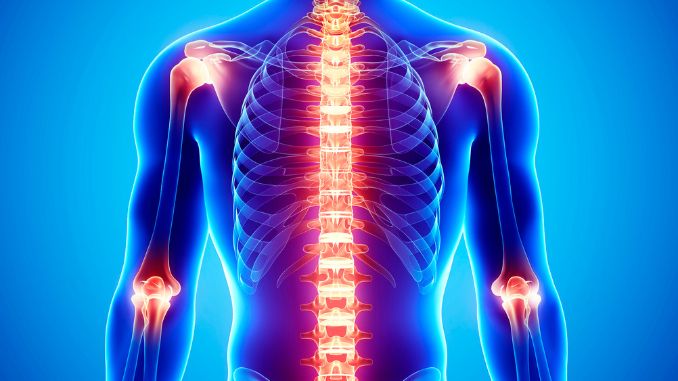A Baker’s Cyst, a fluid-filled swelling at the back of the knee, can hinder daily activities and lead individuals to seek alternative remedies.
This article digs into the potential advantages of incorporating natural food vitamins for Baker’s Cyst symptoms, aiming to shed light on complementary strategies for alleviating discomfort and promoting better joint function.
By thoroughly exploring joint health and inflammation mitigation, we examine the specific nutrients that might provide relief. From anti-inflammatory vitamins to minerals supporting joint health, understanding the potential contributions of these elements becomes essential in enhancing overall joint well-being.
What is Baker’s Cyst?
Baker’s Cyst, a popliteal fluid-filled swelling, develops at the back of the knee. Moreover, this cyst is typically a result of underlying knee joint conditions, such as arthritis, cartilage tear, or meniscus tears, which lead to an accumulation of synovial fluid.
The synovial fluid, responsible for lubricating the knee joint and maintaining joint space, can bulge through the back of the knee, forming a cystic swelling. Baker’s Cyst often presents as a soft lump accompanied by pain, stiffness, and tightness behind the knee.
Vitamins for Baker’s Cyst: While the cyst itself is generally benign and usually baker cyst temporary, addressing the underlying knee condition is crucial for comprehensive management and relief of symptoms. Moreover, it’s important to rule out more serious complications like a blood clot and consider alternative forms of treatment for long-term joint health.
Additionally, incorporating vitamins for Baker’s Cyst may be beneficial, with a focus on vitamins such as C and E, which can support joint health and reduce inflammation.
Nutritional Support for Baker’s Cyst
Here is the spectrum of vitamins, minerals, and compounds, each carefully selected for its potential to provide relief and support for individuals grappling with Baker’s Cyst:
1. Omega-3 Fatty Acids
Omega-3 fatty acids in fatty fish are renowned for their anti-inflammatory properties. These essential fatty acids promote joint health by helping reduce inflammation and supporting overall cardiovascular well-being. Moreover, incorporating sources like flaxseeds, chia seeds, and walnuts into your diet can offer plant-based alternatives for those seeking omega-3s.
Additionally, fish oil capsules, a popular supplement, provide a concentrated source of these beneficial fatty acids, potentially aiding in managing inflammation associated with Baker’s Cyst.
2. Turmeric/Curcumin
Turmeric, a vibrant spice commonly found in curry dishes, contains curcumin, a powerful anti-inflammatory compound. Widely recognized for its medicinal properties, curcumin can relieve symptoms and reduce inflammation associated with joint conditions.
Integrating turmeric into cooking or opting for curcumin supplements may contribute to the nutritional support for Baker’s Cyst, offering a natural approach to managing inflammation.
3. Ginger
Renowned for its distinctive flavor and aroma, ginger possesses anti-inflammatory and analgesic properties that can benefit individuals with Baker’s Cyst. Whether incorporated fresh or as a spice in cooking or consumed as a supplement, ginger may lower pain and swelling linked with the condition. This versatile root has been a staple in traditional medicine for its potential to soothe inflammatory responses and improve overall joint function.
4. Vitamin D
Vitamin D, or “sunshine vitamin” in fatty fish and fortified dairy products, is vital to bone health and immune function. Incorporating these vitamins for Baker’s Cyst helps calcium absorption, essential for maintaining strong bones and overall joint integrity. For individuals with less sun exposure, vitamin D supplements in capsules may be recommended, providing additional support for bone health and potentially aiding in managing Baker’s Cyst symptoms.
5. Vitamin C
Vitamins for Baker’s Cyst: Vitamin C is a potent antioxidant essential for synthesizing collagen, a key component of cartilage and connective tissues. Abundantly present in citrus fruits, strawberries, and bell peppers. This vitamin supports the immune system and contributes to joint health.
While dietary sources are preferred, incorporating vitamins for Baker’s Cyst, such as vitamin C capsules can be considered a supplement to ensure adequate intake, potentially offering anti-inflammatory benefits for individuals with Baker’s Cyst.
6. Vitamin E
Vitamin E, a fat-soluble antioxidant, incorporating these vitamins for baker’s cyst, also contributes to the protection of cells from oxidative stress. Nuts, seeds, and spinach are rich dietary sources of vitamin E, which aid in reducing inflammation associated with Baker’s Cyst. Vitamin E supplements, available in capsule form, can support joint health and overall well-being.
7. Calcium
Calcium is a vital mineral essential for bone health and muscle function. Dairy products, leafy greens, and fortified plant-based milk offer dietary sources of calcium. Adequate calcium intake may indirectly benefit joint function by supporting bone integrity.
Calcium supplements can be considered in various forms if dietary sources are insufficient, potentially contributing to overall joint health.
8. Bromelain
Bromelain, an enzyme found in pineapple, possesses anti-inflammatory properties that may help alleviate swelling and pain associated with Baker’s Cyst. While consuming fresh pineapple can provide natural bromelain, supplements offer a concentrated source.
When taken as a supplement, Bromelain capsules may aid in managing inflammatory responses, offering nutritional support for individuals with Baker’s Cyst.
9. Quercetin
A flavonoid with anti-inflammatory and antioxidant properties, naturally present in foods like apples, onions, and berries. Integrating these foods into your diet can provide quercetin as part of a comprehensive nutritional approach for managing inflammation associated with Baker’s Cyst.
Quercetin supplements, available in capsule form, offer an additional option to ensure sufficient intake of this beneficial compound.
10. Collagen
Collagen is a structural protein crucial for the health of connective tissues, including joints. Bone broth and collagen-rich foods contribute to dietary collagen intake. Collagen supplements, available as powders or capsules, offer a concentrated source and may support joint health, benefiting individuals with Baker’s Cyst.
11. Green Tea
Green tea contains polyphenols, such as catechins, known for their antioxidant and anti-inflammatory effects. Moreover, taking green tea extract capsules or consuming green tea may offer nutritional support for managing inflammation associated with Baker’s Cyst. The potential benefits of green tea extend beyond joint health, making it a versatile addition to a health-conscious diet.
5 Common Symptoms
Baker’s Cyst, or popliteal cyst, can manifest with various symptoms, often related to the underlying knee condition contributing to its formation. Common symptoms associated with Baker’s Cyst include:
1. Knee Swelling
Baker’s Cyst, marked by the accumulation of synovial fluid at the back of the knee, is distinguished by a conspicuous bulge or swelling in the posterior knee region. This characteristic swelling is a prominent sign of the condition, and it’s important to note that the size of the cyst can exhibit significant variability among affected individuals. This swelling indicates the cyst itself and underscores the complex interplay of factors within the knee joint that contribute to the development of Baker’s Cyst.
2. Chronic Knee Pain
One prevalent and often distressing symptom associated with Baker’s Cyst is discomfort or pain behind the knee. This discomfort is particularly pronounced during the extension or full flexion of the knee joint. The spectrum of pain experienced by individuals with Baker’s Cyst can range from mild to severe, contributing to the overall discomfort and affecting the daily activities and mobility of those affected. Understanding the nuances of this pain is critical for proper diagnosis and effective management of the condition.
3. Stiffness
Knee joint stiffness is a common and notable symptom of Baker’s Cyst. This stiffness becomes particularly evident when attempting to straighten or bend the leg, impeding the normal range of motion. The restricted flexibility and difficulty moving the affected knee are consequences of the cyst’s impact on the joint. This aspect of the symptomatology underscores the dynamic nature of Baker’s Cyst and its influence on the mechanical functioning of the knee.
4. Limited Range of Motion
The presence of Baker’s Cyst often results in a discernible limitation in the range of motion in the affected knee. Reduced flexibility and difficulty moving the knee are characteristic features, emphasizing the physical hindrance imposed by the cyst. The impaired range of motion adds a layer of complexity to the symptoms, affecting the daily routine and quality of life for individuals grappling with this condition.
5. Tightness:
A prevalent sensation reported by individuals with Baker’s Cyst is a feeling of tightness or pressure behind the knee. This tightness contributes to the overall discomfort associated with the condition and is considered a significant component of the symptomatology. Understanding the subjective experiences of tightness provides valuable insights into the multifaceted nature of Baker’s Cyst and its impact on the sensory perceptions of those affected.
6 Main Causes of Baker’s Cyst
Baker’s Cyst, a popliteal cyst, is primarily caused by underlying conditions affecting the knee joint. The main causes include:
1. Knee Joint Conditions
-
-
Osteoarthritis
-
Osteoarthritis is a common joint disease that affects the knee and poses a complex challenge. It causes the gradual breakdown of cartilage, the protective tissue in the joint, leading to pain, swelling, and reduced knee flexibility. This deterioration also results in bone spurs and changes in joint structure.
Healthcare professionals need to understand the mechanisms of osteoarthritis to develop effective treatments for symptom relief and overall joint health improvement.
-
-
Rheumatoid Arthritis
-
Rheumatoid arthritis, an autoimmune disorder, uniquely affects the knee joint by causing chronic inflammation of the synovial membrane. This inflammation leads to pain, swelling, and joint damage, including cartilage and bone erosion and deformities.
Healthcare providers must understand the immunological aspects of rheumatoid arthritis to develop effective treatment plans.
-
-
Meniscus Tears
-
Meniscus tears represent a common form of knee joint injury, impacting the crescent-shaped cartilage that cushions between the thigh bone and shinbone. These tears often occur due to sudden twisting or rotational knee movements, commonly seen in sports-related activities.
The meniscus plays a pivotal role in distributing weight and maintaining stability in the knee joint, and injuries to this crucial structure can result in pain, swelling, and a restricted range of motion. In some cases, meniscus tears may cause mechanical symptoms such as catching or locking the knee during movement.
2. Excessive Synovial Fluid Production
The knee joint, a marvel of biomechanics, relies on synovial fluid to enable the leg swing smoothly and reduce friction between the moving parts of the knee. However, when conditions disrupt this delicate balance, leading to the overproduction of synovial fluid, a cascade of events can occur, ultimately contributing to the formation of a Baker’s Cyst.
Disorders such as arthritis, characterized by inflammation within the joint, can instigate an abnormal increase in synovial fluid production. The resultant surplus of fluid seeks refuge in the form of a cyst, accentuating the intricate relationship between joint physiology and the development of this particular knee ailment.
3. Inflammatory Joint Diseases
Beyond the realm of conventional joint conditions, inflammatory joint diseases significantly influence the genesis of Baker’s Cyst. Conditions like gout or pseudogout, distinguished by the accumulation of crystals within the joints, emerge as key contributors to the formation of this cystic entity.
The intricate interplay of inflammatory processes within the joint sets the stage for developing a Baker’s Cyst, highlighting the diverse factors that can converge to create this specific manifestation of knee joint pathology.
4. Trauma or Injury
The resilience of the knee joint can be compromised by direct trauma or injury, precipitating the initiation of a Baker’s Cyst. A forceful blow or impactful incident to the knee can disturb the delicate equilibrium within the joint, triggering mechanisms that lead to the formation of the cyst.
This direct cause-and-effect relationship underscores the vulnerability of the knee to external forces. It emphasizes the dynamic nature of Baker’s Cyst as a response to traumatic events impacting the joint’s structural integrity.
5. Joint Infections
Infections, a formidable adversary to joint health, can instigate a chain reaction within the knee joint, culminating in inflammation and fluid accumulation characteristic of Baker’s Cyst. Infections affecting the knee joint set the stage for a complex interplay of immune responses and inflammatory processes, creating an environment conducive to cyst formation.
6. Age and Degeneration
The inexorable march of time brings with it an increased susceptibility to knee joint conditions that contribute to the development of Baker’s Cyst. Aging individuals often contend with degenerative changes in the knee joint, including the breakdown of cartilage and alterations in joint structure. These age-related transformations, while natural, elevate the risk of conditions such as arthritis and other degenerative joint disorders.
The intricate interplay between age-related degeneration and the emergence of Baker’s Cyst highlights the importance of age as a risk factor and emphasizes the need for tailored interventions to address the specific challenges posed by knee joint aging.
It’s essential to note that Baker’s Cyst is a secondary condition, and addressing the underlying cause is crucial for effective diagnosis and treatment.
Diagnosis
The diagnosis of Baker’s Cyst often involves various imaging studies, which provides valuable insights into the cyst’s presence, size, and location. These imaging tests include Ultrasound, X-ray, and ray Magnetic resonance imaging (MRI).
1. Ultrasound: This non-invasive imaging procedure uses sound waves to produce real-time images of the knee joint. It effectively visualizes the cyst, assesses its size, and differentiates it from other knee issues.
2. Magnetic Resonance Imaging (MRI): This provides highly detailed images of the knee and surrounding structures. It is considered one of the most comprehensive methods for diagnosing Baker’s Cyst, offering precise information about its size, location, and associated complications.
3. X-rays: While X-rays don’t directly visualize the cyst, they help rule out other causes of knee pain and swelling, such as fractures or osteoarthritis. X-rays are often included in the diagnostic process to ensure a comprehensive evaluation of the knee joint.
Treatment Options
Sometimes, a Baker’s Cyst may resolve on its own, especially with mild symptoms that can be managed by avoiding activities that exacerbate them. However, if the cyst is large and causing pain, treatment options include:
a. Steroid Injection: A healthcare provider may administer a steroid injection, like cortisone, into the knee to reduce inflammation. This can shrink the cyst and alleviate pain, although it may not prevent recurrence.
b. Physical Therapy: Therapies gentle exercises aimed at improving knee range of motion and strengthening the surrounding muscles can help manage symptoms and preserve knee function.
c. Needle Aspiration: To reduce the cyst’s size, needle aspiration may be performed. This involves emptying the fluid from the cyst using a needle, often guided by ultrasound.
d. Arthroscopic Surgery: If an underlying joint problem is causing the cyst, arthroscopic surgery may be necessary to address it. For example, if a torn cartilage leads to the accumulation of synovial fluid in the knee, the surgeon can repair or remove the damaged cartilage while draining the cyst during the procedure.
Treatment choice depends on the underlying causes, symptoms’ severity, and cyst’s size. A healthcare provider will assess the individual’s condition and advise the best treatment option for Baker’s Cyst.
Lifestyle and Home Remedies
If arthritis is causing the cyst, your healthcare provider may recommend you to take some or all of the following steps:
A. Follow the principles of R.I.C.E. These letters stand for Rest, Ice, Compression, and Elevation.
-
- Rest. Take a rest for your leg.
- Ice. Apply ice to your knee.
- Compress. Use a wrap, sleeve, or brace to compress your knee.
- Elevate. Elevate your leg whenever feasible, particularly during the night.
B. Try a nonprescription pain reliever. Drugs such as ibuprofen (Advil, Motrin I.B., others), aspirin, acetaminophen (Tylenol, others), and naproxen sodium (Aleve, others) help relieve pain. Mind the dosing instructions on the container. Don’t take more than the advised dosage.
C. Lessen your physical activity. Following this, reduce irritation of your knee joint. Your healthcare provider can assist you to the lengths you need to reduce your activity levels. Your provider can suggest alternative forms of exercise you can do in the meantime.
Conclusion
A combined approach of tailored exercises and a balanced diet, guided by healthcare professionals, offers an effective way to manage Baker’s Cyst. Moreover, this holistic strategy considers lifestyle factors, combining specific nutrients with muscle-strengthening exercises to address underlying causes and alleviate inflammation and discomfort. Healthcare providers ensure personalized and safe plans, aiming for immediate relief and long-term joint health.
Explore the benefits of our 6 Best Natural Pain-Relieving Supplements for Your Joints. Say goodbye to discomfort and embrace joint wellness today!

Rick Kaselj MS, is a leading kinesiologist and injury specialist as well as co-creator of the best-selling Unlock Your Hip Flexors program. Rick creates exercise programs that help people heal injuries and eliminate pain, so they can go back to living a full, active, healthy life.






















